An Improved User Association Algorithm for MAP–FAPs Heterogeneous Networks
Abstract
:1. Introduction
2. System Model
3. Problem Formulation and Optimal Solution
3.1. Single Subcarrier User Rate
3.2. Approximated Problem and Problem Formulation
4. The Proposed Algorithm
- 1.
- InitializationL FAPs and K users are randomly generated within the scope of MAP. Initialize , . Set that the AP can serve a maximum of users. To simplify, assume that each FAP has the same maximum service user number, , and to make sure that every available user will be served, MAP sets its quota to be equal to the maximum number of UEs.
- 2.
- Pre-selectionfor to KCalculate the user rate when it connects to the AP, then the user preselects the AP who can support the highest user rate.endThen , , and are obtained.
- 3.
- Final selectionif=, =endfor to LCalculate . Then sort in an increasing manner; namely, . Select the last users according to the order.Accordingly, we obtain,end
5. Simulation Results
5.1. Simulation Configuration
5.2. Simulation Analysis
6. Conclusions
Acknowledgments
Author Contributions
Conflicts of Interest
References
- Liu, D.; Wang, L.; Chen, Y.; Elkashlan, M.; Wong, K.; Schober, R.; Hanzo, L. User association in 5G networks: A survey and an outlook. IEEE Commun. Surv. Tutor. 2016, 18, 1018–1044. [Google Scholar] [CrossRef]
- Andrews, J.G.; Claussen, H.; Dohler, M.; Rangan, S.; Reed, M.C. Femtocells: Past, present, and future. IEEE J. Sel. Areas Commun. 2012, 30, 497–508. [Google Scholar] [CrossRef]
- Peng, M.; Wang, C.; Li, J.; Xiang, H.; Lau, V. Recent advances in underlay heterogeneous networks: Interference control, resource allocation, and self-organization. IEEE Commun. Surv. Tutor. 2015, 17, 700–729. [Google Scholar] [CrossRef]
- Li, Y.B.; Yang, R.; Ye, F.; Gao, Z. Improved spectrum sharing algorithm based on feedback control information in cognitive radio networks. J. Syst. Eng. Electron. 2013, 24, 564–570. [Google Scholar] [CrossRef]
- Lee, Y.L.; Chuah, T.C.; Loo, J.; Vinel, A. Recent advances in radio resource management for heterogeneous LTE/LTE-A networks. IEEE Commun. Surv. Tutor. 2014, 16, 2142–2180. [Google Scholar] [CrossRef]
- Luan, Z.; Qu, H.; Zhao, J.; Chen, B. Low complexity distributed max-throughput algorithm for user association in heterogeneous network. Wirel. Pers. Commun. 2016, 87, 1147–1156. [Google Scholar] [CrossRef]
- Song, W.; Jiang, H.; Zhuang, W. Performance analysis of the WLAN-first scheme in cellular/WLAN interworking. IEEE Trans. Wirel. Commun. 2007, 6, 1932–1952. [Google Scholar] [CrossRef]
- Nie, J.; Wen, J.C.; Dong, Q.; Zhou, Z. A seamless handoff in IEEE 802.16 a and IEEE 802.11 n hybrid networks. In Proceedings of the IEEE 2005 International Conference on Communications, Circuits and Systems, Hong Kong, China, 27–30 May 2005; Volume 1, pp. 383–387.
- Roy, J.J.J.; Vaidehi, V.; Srikanth, S. Always best-connected QoS integration model for the WLAN, WiMAX heterogeneous network. In Proceedings of the IEEE First International Conference on Industrial and Information Systems, Moratuwa, Sri Lanka, 8–11 August 2006; pp. 361–366.
- Lasaulce, S.; Tembine, H. Game Theory and Learning for Wireless Networks: Fundamentals and Applications; Academic Press: New York, NY, USA, 2011. [Google Scholar]
- Liang, L.; Feng, G.; Jia, Y. Game-theoretic hierarchical resource allocation for heterogeneous relay networks. IEEE Trans. Veh. Technol. 2015, 64, 1480–1492. [Google Scholar] [CrossRef]
- Bayat, S.; Louie, R.H.Y.; Han, Z.; Vucetic, B.; Li, Y. Distributed user association and femtocell allocation in heterogeneous wireless networks. IEEE Trans. Commun. 2014, 62, 3027–3043. [Google Scholar] [CrossRef]
- Xue, P.; Gong, P.; Park, J.H.; Park, D.; Kim, D.K. Radio resource management with proportional rate constraint in the heterogeneous networks. IEEE Trans. Wirel. Commun. 2012, 11, 1066–1075. [Google Scholar] [CrossRef]
- Wong, I.C.; Shen, Z.; Evans, B.L.; Andrews, J.G. A low complexity algorithm for proportional resource allocation in OFDMA systems. In Proceedings of the SIPS IEEE Workshop on Signal Processing Systems, Austin, TX, USA, 13–15 October 2004; pp. 1–6.
- Shen, Z.; Andrews, J.-G.; Evans, B.-L. Adaptive resource allocation in multiuser OFDM systems with proportional rate constraints. IEEE Trans. Wirel. Commun. 2005, 4, 2726–2737. [Google Scholar] [CrossRef]
- Zheng, J.; Li, J.D.; Shi, H.; Liu, Q.; Yang, X.N. Joint subcarrier, code, and power allocation for parallel multi-radio access in heterogeneous wireless networks. Sci. China Inf. Sci. 2014, 57, 1–5. [Google Scholar] [CrossRef]
- Li, Y.; Nie, W.; Ye, F. A complex mixing matrix estimation algorithm based on single source points. Circuits Syst. Signal Process. 2015, 34, 3709–3723. [Google Scholar] [CrossRef]
- Jia, C.; Lim, T.J. Resource partitioning and user association with sleep-mode base stations in heterogeneous cellular networks. IEEE Trans. Wirel. Commun. 2015, 14, 3780–3793. [Google Scholar] [CrossRef]
- Ye, Q.; Rong, B.; Chen, Y.; Al-Shalash, M.; Caramanis, C.; Andrews, J.G. User association for load balancing in heterogeneous cellular networks. IEEE Trans. Wirel. Commun. 2013, 12, 2706–2716. [Google Scholar] [CrossRef]
- Shen, K.; Yu, W. Distributed pricing-based user association for downlink heterogeneous cellular networks. IEEE J. Sel. Areas Commun. 2014, 32, 1100–1113. [Google Scholar] [CrossRef]
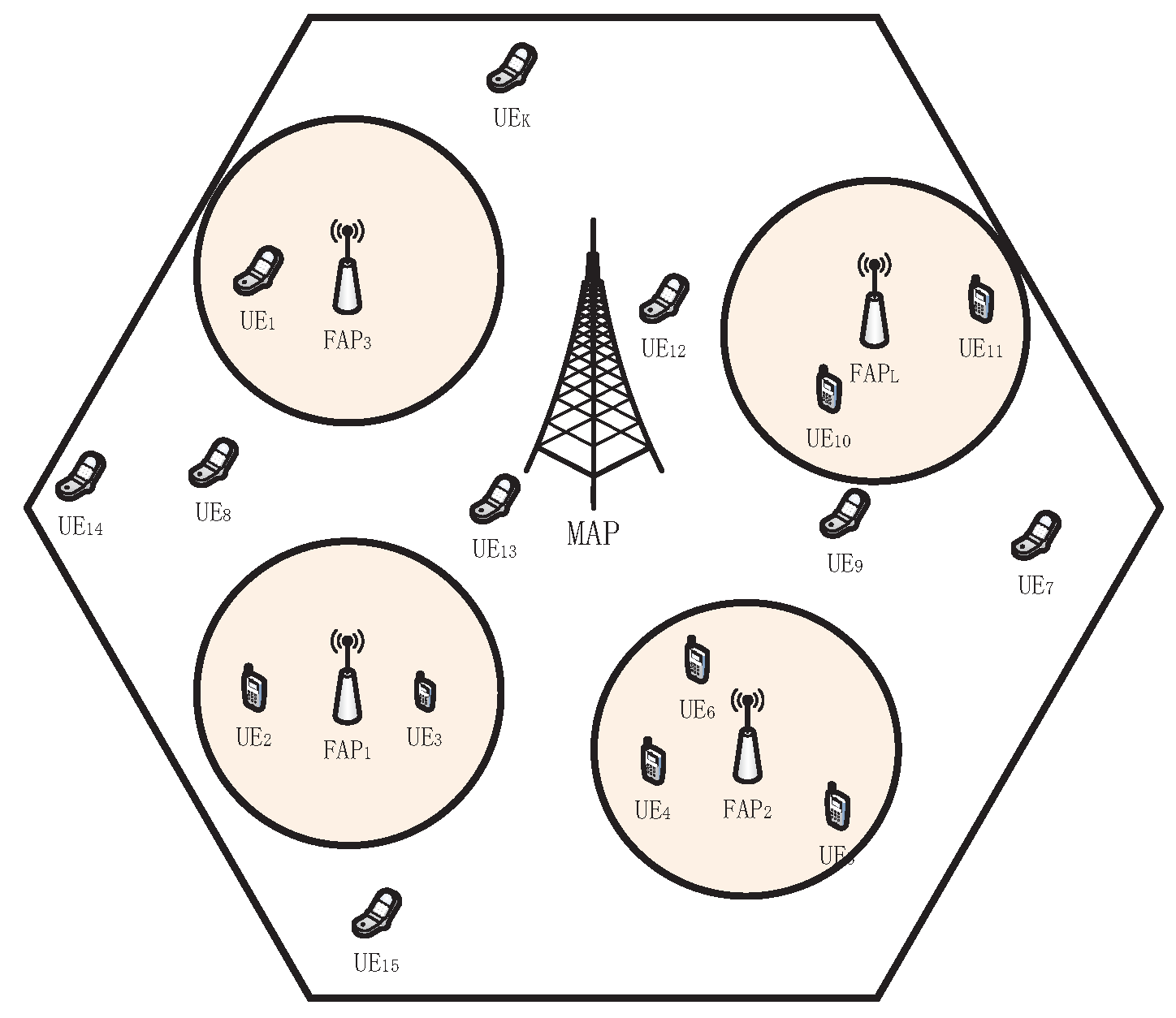
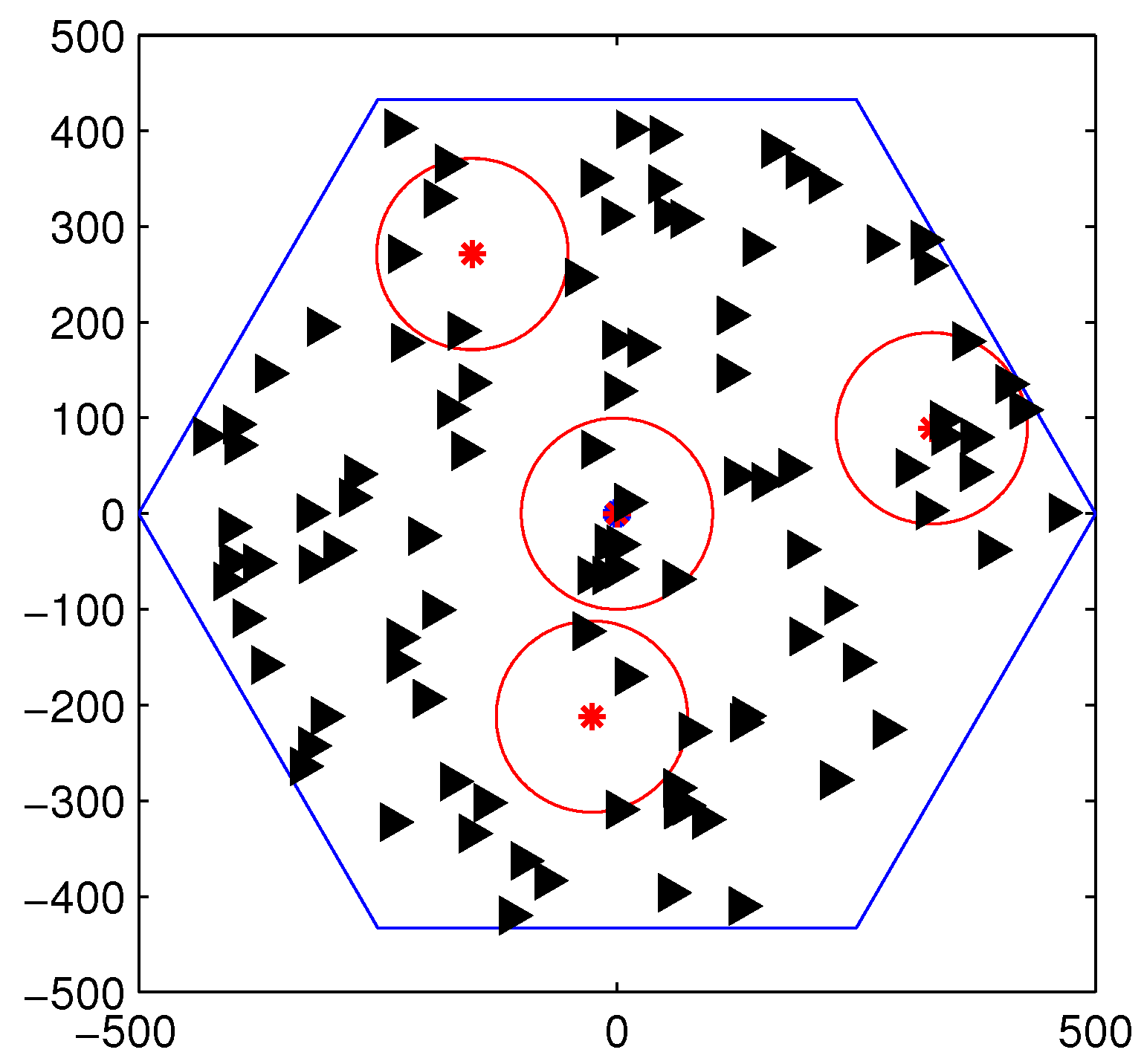
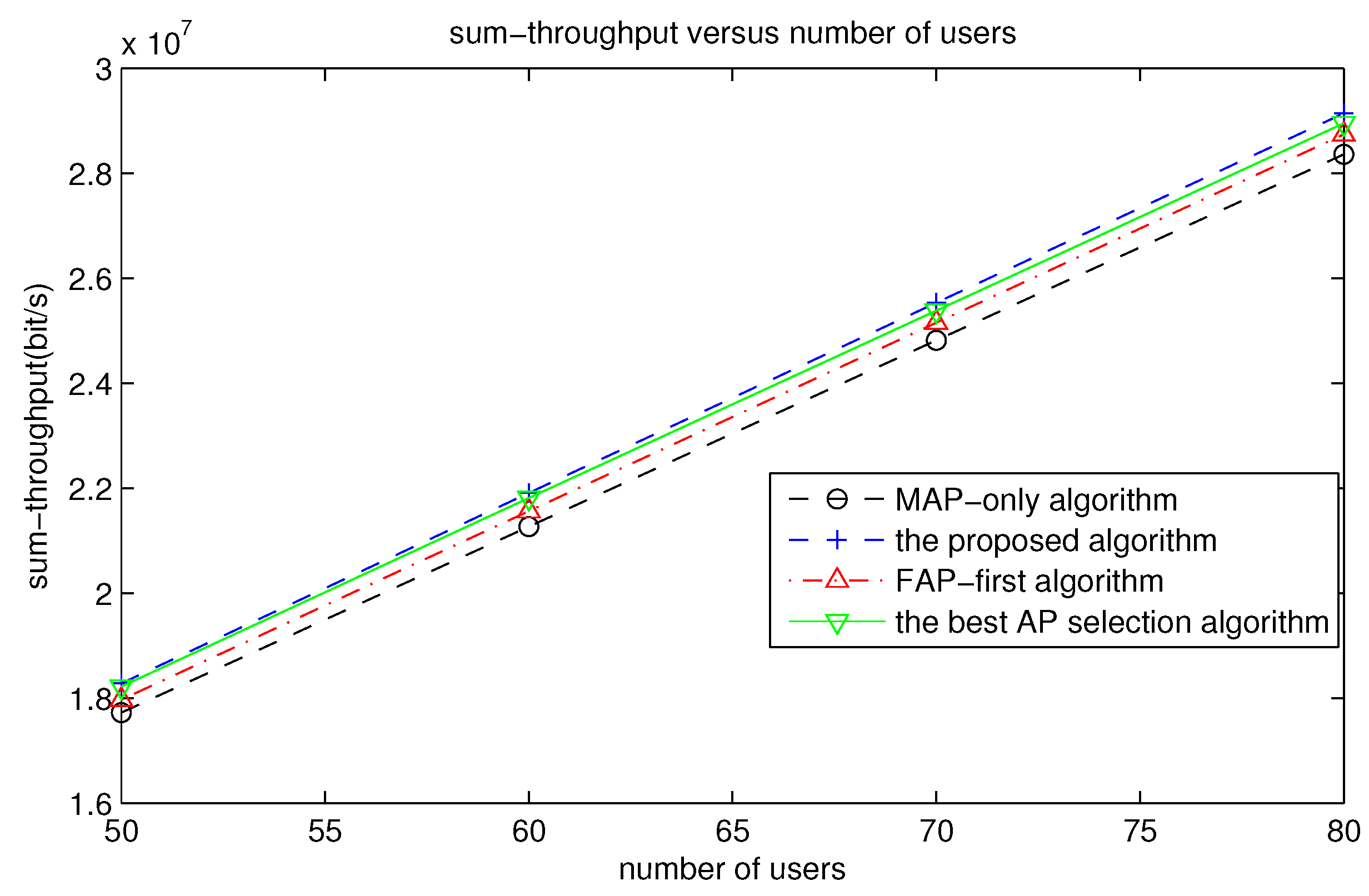

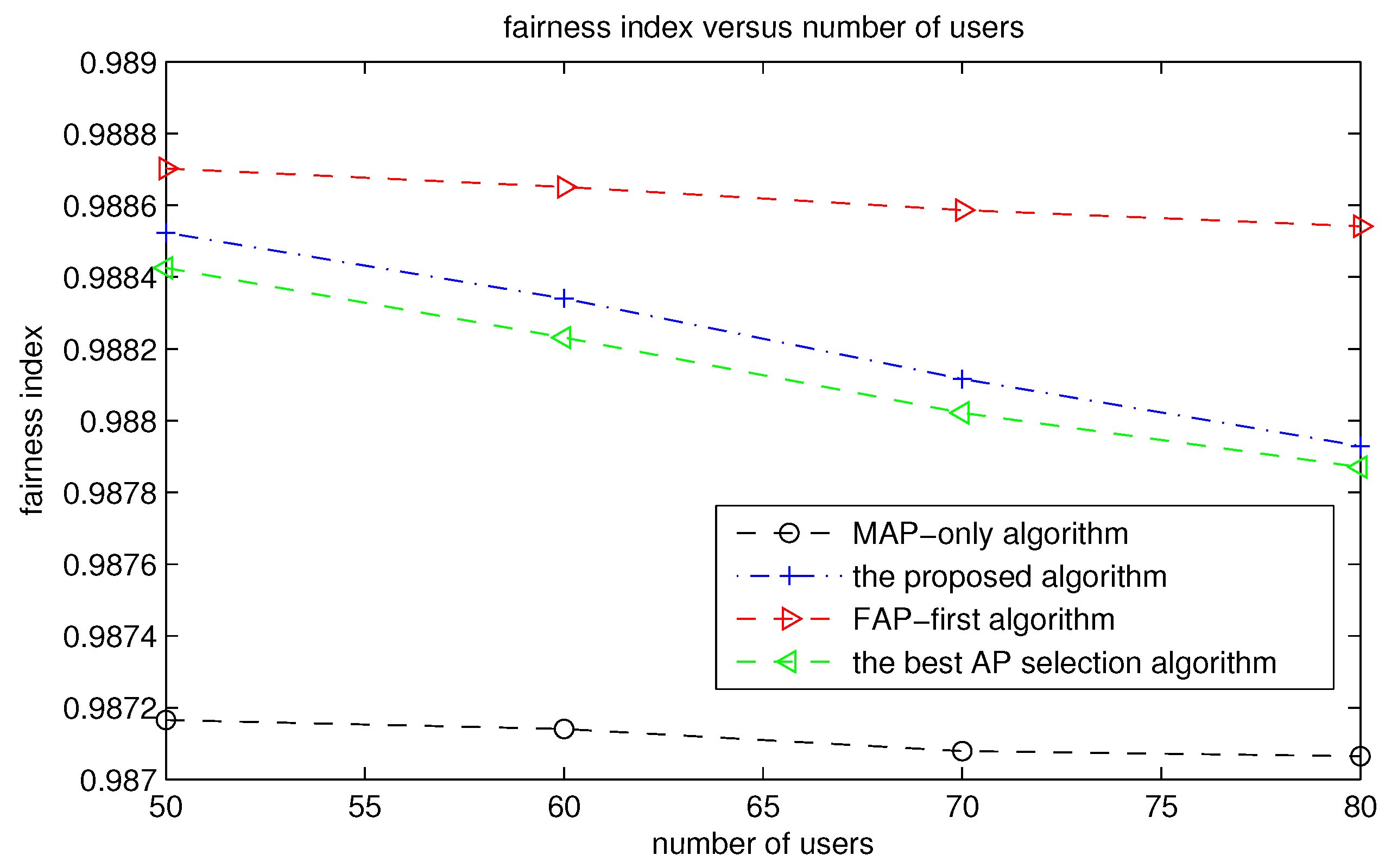
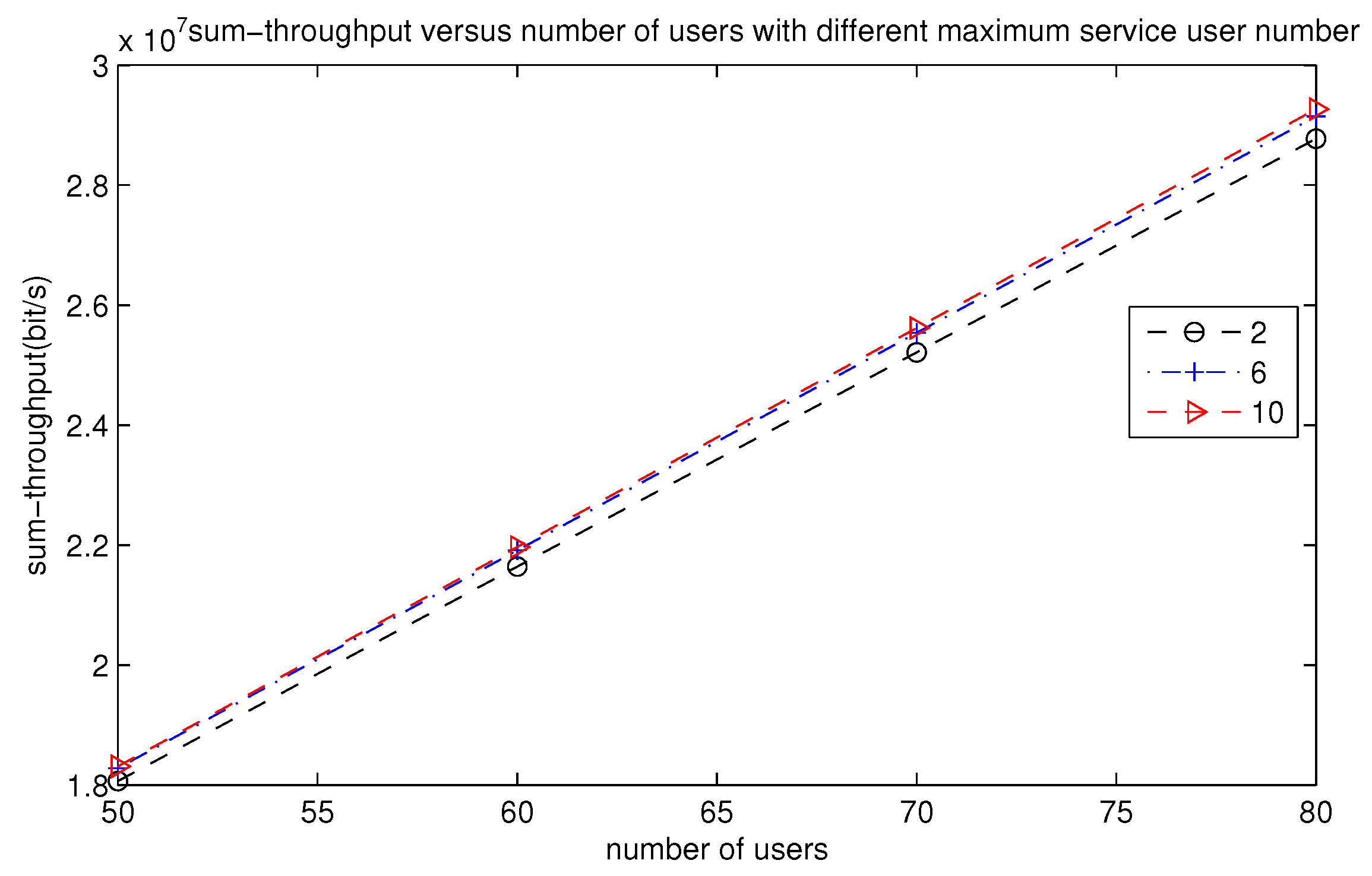

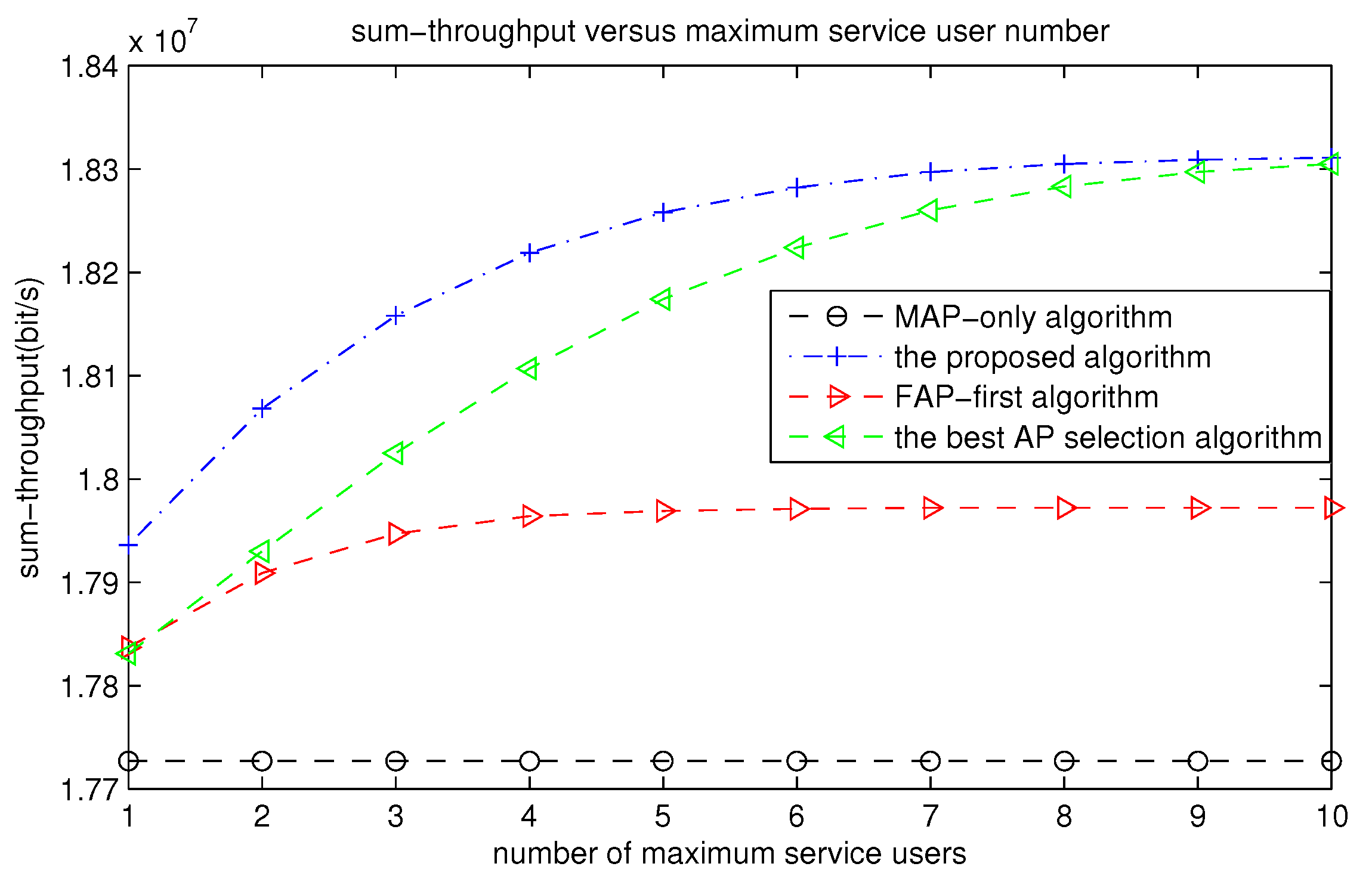
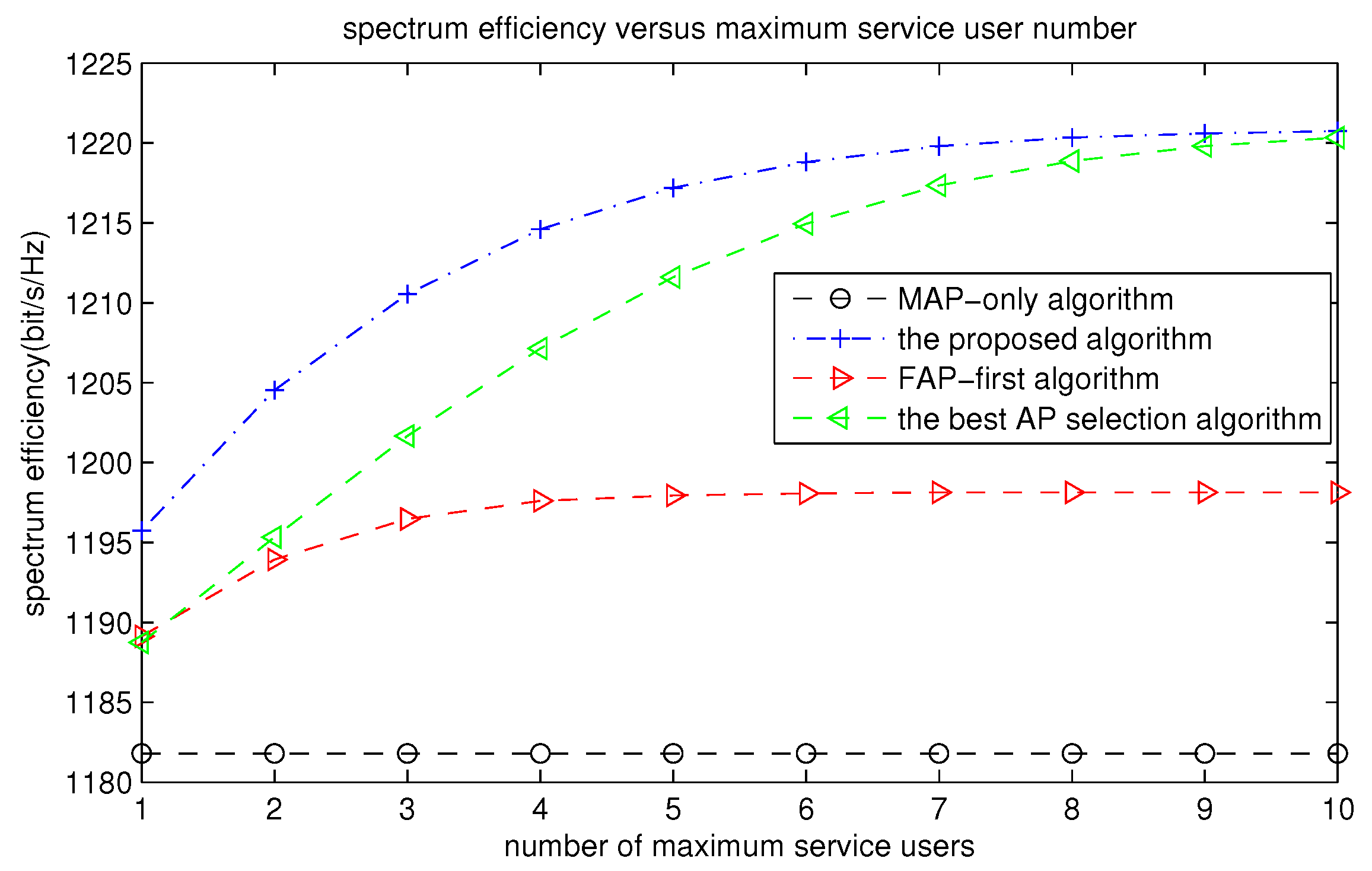
| Parameter | Value |
|---|---|
| MAP transmission power | 43 dBm |
| FAP transmission power | 20 dBm |
| Bandwidth of subcarrier | 15 KHz |
| Path loss (MAP) | 15.3 + 37.6 lg(d) |
| Path loss (FAP) | 38.46 + 20 lg(d) |
| Shadowing | Log-normal, 8 dB standard deviation |
| Noise power density | −174 dBm/Hz |
| Algorithms | Sum-Throughput ( bit/s) | Improvement over MAP-Only (Percent) |
|---|---|---|
| The proposed algorithm | 2.5536 | 2.893 |
| The best AP selection | 2.5388 | 2.297 |
| FAP-first | 2.5155 | 1.358 |
| MAP-only | 2.4818 | 0 |
| Algorithms | Spectrum Efficiency ( bit/s/Hz) | Improvement over MAP-Only (Percent) |
|---|---|---|
| The proposed algorithm | 1.7024 | 2.895 |
| The best AP selection | 1.6925 | 2.297 |
| FAP-first | 1.6770 | 1.360 |
| MAP-only | 1.6545 | 0 |
| Algorithms | Fairness Index | Decrease from FAP-First (Percent) |
|---|---|---|
| FAP-first | 0.9886 | 0 |
| The proposed algorithm | 0.9881 | 0.051 |
| The best AP selection | 0.9880 | 0.061 |
| MAP-only | 0.9871 | 0.152 |
© 2016 by the authors; licensee MDPI, Basel, Switzerland. This article is an open access article distributed under the terms and conditions of the Creative Commons Attribution (CC-BY) license (http://creativecommons.org/licenses/by/4.0/).
Share and Cite
Ye, F.; Su, C.; Li, Y. An Improved User Association Algorithm for MAP–FAPs Heterogeneous Networks. Symmetry 2016, 8, 151. https://doi.org/10.3390/sym8120151
Ye F, Su C, Li Y. An Improved User Association Algorithm for MAP–FAPs Heterogeneous Networks. Symmetry. 2016; 8(12):151. https://doi.org/10.3390/sym8120151
Chicago/Turabian StyleYe, Fang, Chunxia Su, and Yibing Li. 2016. "An Improved User Association Algorithm for MAP–FAPs Heterogeneous Networks" Symmetry 8, no. 12: 151. https://doi.org/10.3390/sym8120151






